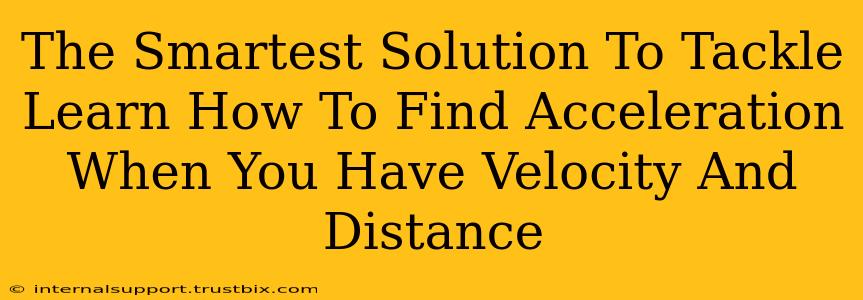Finding acceleration when you only know velocity and distance might seem tricky, but it's entirely solvable with the right approach. This guide breaks down the process step-by-step, offering the smartest solution to conquer this physics problem. We'll explore different scenarios and provide practical examples to solidify your understanding.
Understanding the Fundamentals: Acceleration, Velocity, and Distance
Before diving into the solution, let's refresh our understanding of the core concepts:
-
Acceleration: The rate at which an object's velocity changes over time. It's measured in meters per second squared (m/s²) or other relevant units. Acceleration can be positive (speeding up), negative (slowing down), or zero (constant velocity).
-
Velocity: The rate of change of an object's position. It's a vector quantity, meaning it has both magnitude (speed) and direction. Velocity is measured in meters per second (m/s) or similar units.
-
Distance: The total length of the path traveled by an object. It's a scalar quantity, meaning it only has magnitude. Distance is measured in meters (m), kilometers (km), or other units of length.
The Challenge: Finding Acceleration Without Time
The standard formula for acceleration (a = (v_f - v_i)/t) requires knowing the initial velocity (v_i), final velocity (v_f), and time (t). The problem arises when you're only given velocity and distance. The key is to find a way to eliminate time from the equation.
The Smartest Solution: Using Kinematic Equations
We can use kinematic equations, which relate displacement, velocity, acceleration, and time. The most useful equation in this case is:
v_f² = v_i² + 2as
Where:
- v_f is the final velocity
- v_i is the initial velocity
- a is the acceleration
- s is the distance
This equation cleverly eliminates time, allowing us to calculate acceleration using only velocity and distance.
Step-by-Step Solution
-
Identify your knowns: Determine the values of your initial velocity (v_i), final velocity (v_f), and distance (s). Make sure your units are consistent.
-
Rearrange the equation: Solve the equation above for acceleration (a):
a = (v_f² - v_i²) / 2s
-
Plug in your values: Substitute the known values of v_f, v_i, and s into the rearranged equation.
-
Calculate the acceleration: Perform the calculation to find the acceleration (a). Remember to include the correct units (m/s²).
Example Problem
A car accelerates from 10 m/s to 20 m/s over a distance of 150 meters. What is its acceleration?
-
Knowns: v_i = 10 m/s, v_f = 20 m/s, s = 150 m
-
Rearranged equation: a = (v_f² - v_i²) / 2s
-
Plug in values: a = (20² - 10²) / (2 * 150)
-
Calculate: a = (400 - 100) / 300 = 1 m/s²
Therefore, the car's acceleration is 1 m/s².
Important Considerations
-
Direction: Remember that acceleration is a vector quantity. The sign of your answer indicates the direction of the acceleration. Positive acceleration means acceleration in the direction of motion, while negative acceleration means deceleration or acceleration in the opposite direction.
-
Constant Acceleration: These equations assume constant acceleration. If the acceleration is not constant, these methods will not be accurate. You would need to employ calculus-based methods to solve for the acceleration in these scenarios.
-
Units: Always double-check your units to ensure consistency throughout the calculation.
By mastering this approach, you can confidently tackle problems requiring you to find acceleration when given velocity and distance. Remember to practice with various examples to solidify your understanding and become proficient in solving these physics problems.

